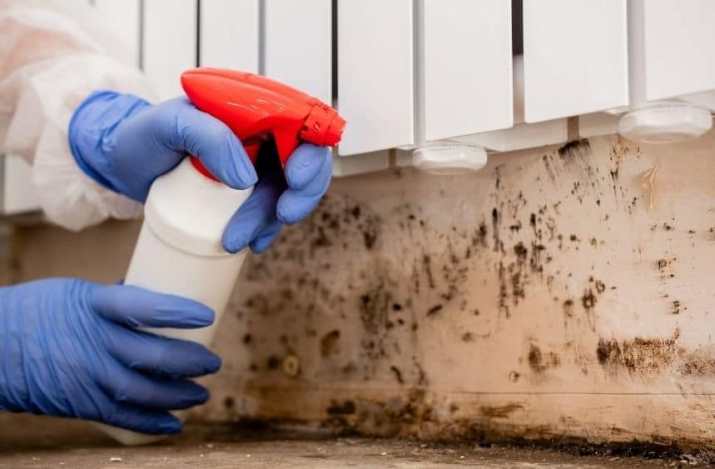Professional remediators will first isolate the area affected by mold by closing all doors and windows to prevent airborne mold spores from disseminating throughout your house.
Homeowners should keep pets out of contaminated areas and clear an access path leading directly to them. Professional remediators will conduct clearance testing after remediation work has been completed to verify its success and that areas remediated are safe for reconstruction & occupancy.
1. Inspection

Mold remediation services should always begin with an inspection to assess the extent of damage and determine what steps must be taken to remedy it. This step involves collecting moisture readings, as well as looking for visual cues and conducting airborne spore testing in affected areas to ascertain the scope of mold infestation.
Porous building materials like drywall and carpet should be removed and discarded if they become severely contaminated, while nonporous materials like plywood subfloors and Douglas fir framing may be cleaned using antimicrobial cleaners or sprays containing biocide.
In order to effectively dry down affected areas, air movers, dehumidifiers, and moisture meters will also be utilized as required to ensure all items have reached an acceptable humidity level.
Because mold spores spread via HVAC systems, air filtration should also be included as an essential component of their service, using negative air machines or HEPA filters if applicable. You can click the link: medlineplus.gov to learn more about HPA filters.
2. Cleaning
Mold cleaning specialists offer an array of services designed to both remove the visible growth as well as stop its spread.
Typically they will use polythene sheeting to protect non-affected areas from spreading mold spores; additionally they may set up a room between infected area and the rest of the building for containment purposes; additionally they use air movers and dehumidifiers to ensure low humidity environments that are essential to good health in buildings containing infected areas.
Building materials contaminated with mold or bacteria are collected into industrial bags before being treated with antimicrobial or biocide solutions to eliminate any hidden spores that may remain.
Unusable material must then be placed into hazardous waste containers for disposal. Professional mold remediation services will be qualified to determine when the affected area is safe. Be sure to keep clear of the area until it has been cleared.
Keep in mind that mold spores are always present, making eradication impossible. What can be accomplished is bringing their levels down to what’s considered normal fungal ecology through thorough cleaning services as well as remediation services that address issues causing their presence in the first place.
3. Disinfection

Mold thrives when conditions remain damp for an extended period, feeding off organic materials like walls, carpeting and ceilings to produce its food source. If left unchecked it can spread throughout a property posing serious health threats to all occupants. You can learn more by clicking the link.
Once containment is achieved, experts at a remediation service will begin cleaning and disinfecting the affected area with expert methods ranging from wiping with cloth soaked in detergent solution or water to extracting any non-porous materials which have accumulated within it in plastic bags for disposal in order to keep spores from disseminating into the air.
If there are porous items that cannot be removed, a professional will apply a mold resistant encapsulating product to surfaces in the room to stop future growth and recurrence of issues. They will also identify sources of moisture to ensure that this issue has been effectively dealt with.
4. Remediation
Mold spores spread like pollen through the air, and can enter your home and pose health concerns to those with sensitive lungs. Remediation procedures aim to restore indoor air quality back to healthy levels for maximum wellbeing.
Professionals will isolate the affected area by sealing windows and other openings to keep spores from spreading throughout your house. Dehumidifiers and fans may be used to keep it dry while they work, while bagged building materials with mold could be treated with fungicide before disposal.
As soon as the work has been completed, they will conduct another inspection to evaluate moisture readings and visual cues before testing airborne spores to make sure their work was effective.
If clearance testing shows success, reconstruction and occupancy can resume while otherwise they will advise relocation until remediation has taken place – especially important if young children, people with respiratory issues or immunocompromised individuals needing ongoing medication are in the area.
5. Disposal

Mold spores spread quickly and in large quantities, so the best way to minimize damage from their presence is to take immediate steps to eradicate the situation. Unchecked growths could quickly transform into major health concerns for both you and your inhabitants if left unattended.
Mold cleaning typically occurs on non-porous surfaces and typically involves spraying, wiping and scrubbing with detergent solutions to remove mold spores from porous materials contaminated by moisture.
It is essential to have professionals conduct this kind of work in order to ensure that your environment is safe.
